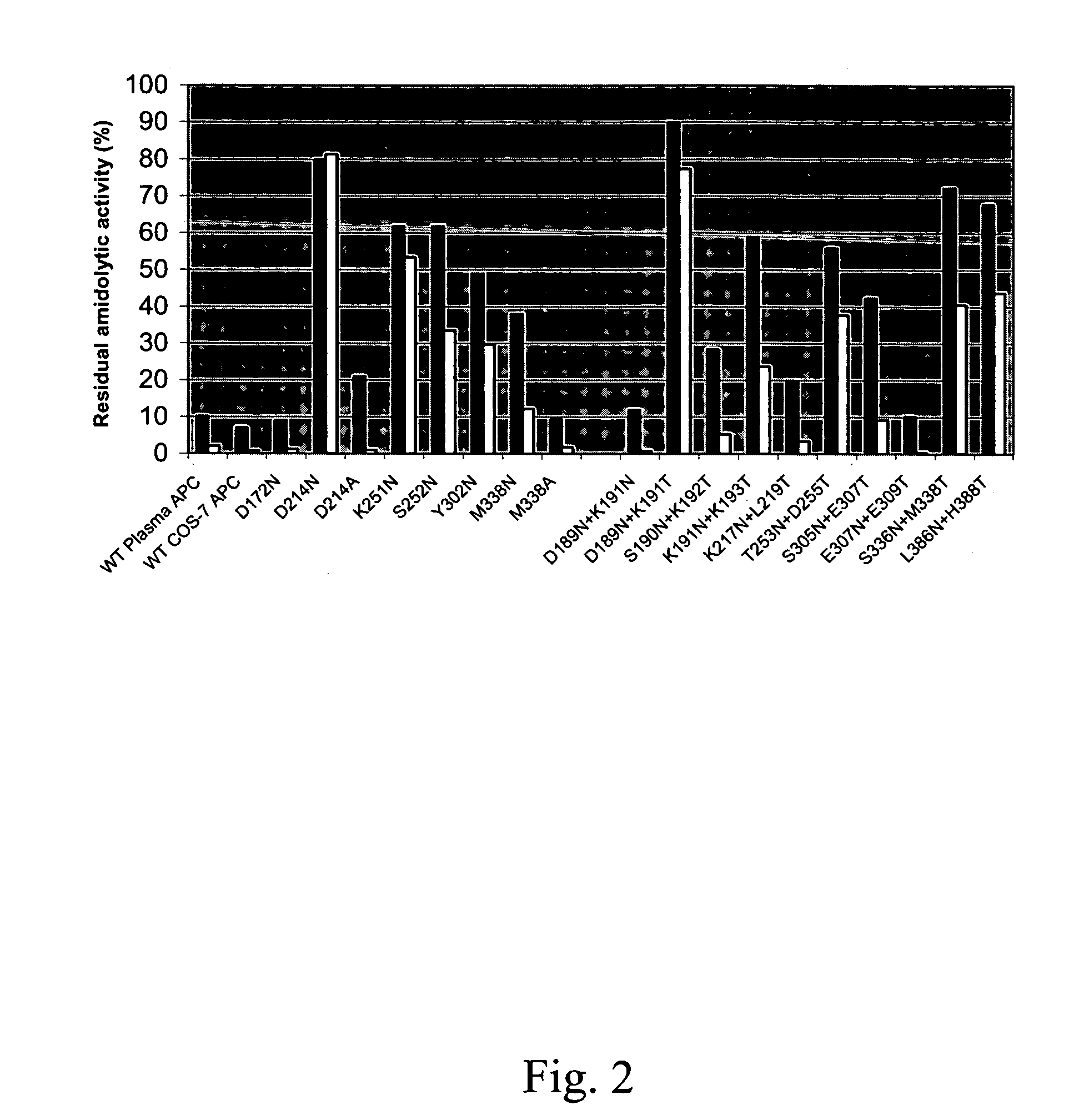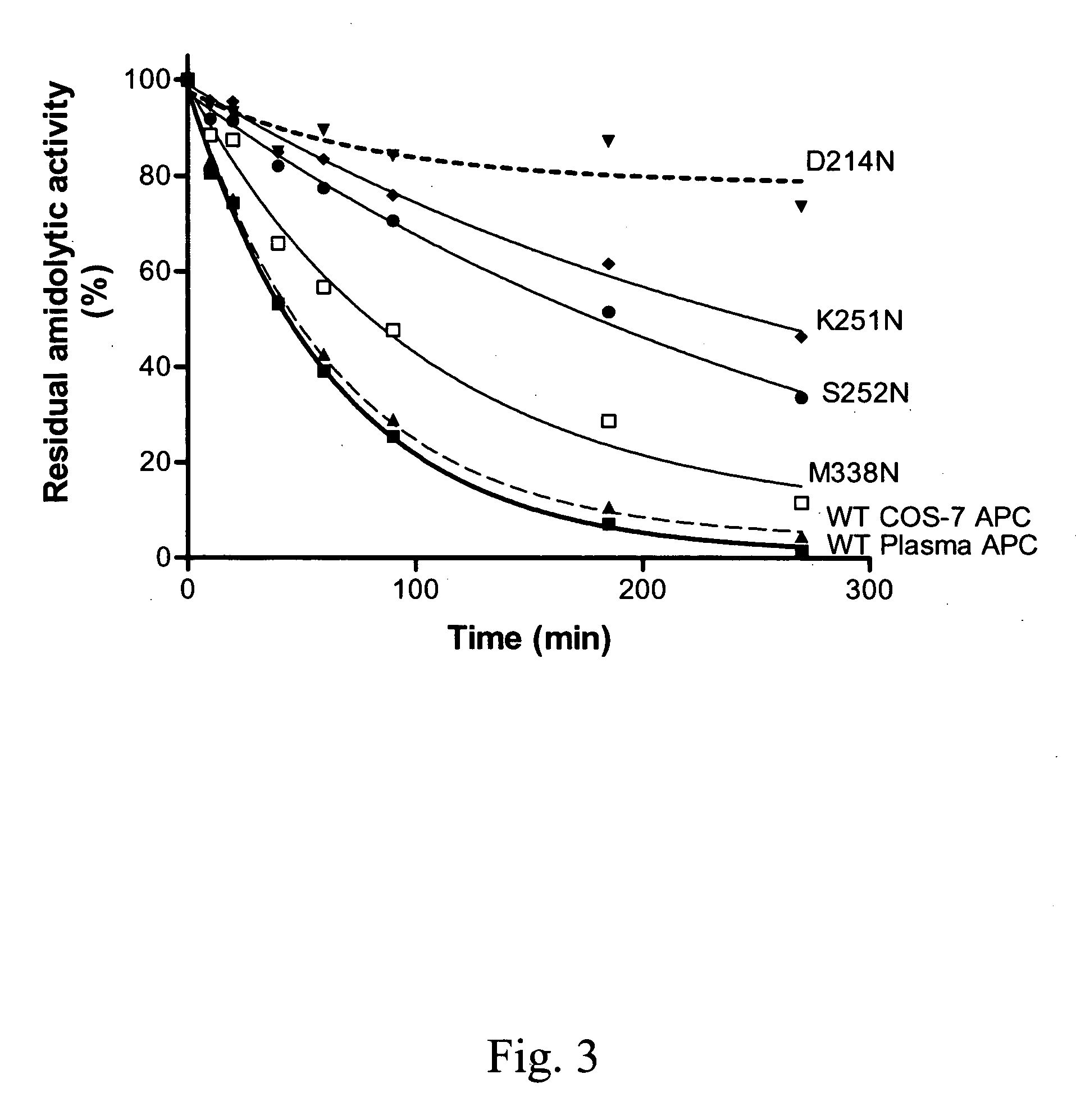Protein C or activated protein C-like molecules
a technology of activated protein and c-like molecules, which is applied in the field of protein c or activated protein c-like molecules, can solve the problems of difficult to obtain adequate dose regulation, difficult to frequent intravenous administration of high levels of apc, and high cos
- Summary
- Abstract
- Description
- Claims
- Application Information
AI Technical Summary
Benefits of technology
Problems solved by technology
Method used
Image
Examples
example 1
Determination of Surface-Exposed Amino Acids
[0239] The coordinates for the X-ray structure of wild-type human APC (Mather, T., Oganessyan, V., Hof, P., Huber, R., Foundling, S., Esmon, C., Bode, W., 1996) are available from the Protein Data Bank (PDB) (Bernstein et. al. J. Mol. Biol. (1977) 112 pp. 535) and electronically available via The Research Collaboratory for Structural Bioinformatics PDB at http: / / www.pdb.org / under accession code 1AUT. All water molecules as well as the covalently bound inhibitor were removed from the structure before the calculation of accessible surface area was done. In the present example the betahydroxy-ASP (AP) at position 71 is treated as a normal ASP residue. The residues K156-R169 (the Lys-Arg dipeptide and the activation peptide) were not included in the calculations.
[0240] Sequence Numbering
[0241] The sequence numbering used in this example is identical to the sequence numbering of the zymogen protein C having the amino acid sequence SEQ ID NO:...
example 2
Determination of Active Site Region
[0246] In determining the active site region the following approach was followed: By super-imposing the heavy chain of APC (1AUT) onto the X-ray structure of a ternary complex between Factor VIIa, Tissue Factor and a variant of BPTI bound in the active site (PDB accession code 1FAK. See Zhang, E., St Charles, R., Tulinsky, A.: Structure of Extracellular Tissue Factor Complexed with Factor Viia Inhibited with a Bpti Mutant J. Mol. Biol. 285 pp. 2089 (1999)) using the program Modeller '98 enabled the definition of the “active site region” as any residue 1 in the APC heavy chain having an atom within a distance of 12A from the superimposed BPTI molecule. Furthermore, from a visual inspection a loop just outside this region (residues 306-314) was also considered to constitute part of the active site region.
[0247] Using this approach the following amino acid residues were found to be included in the “active site region”:
[0248] L170, I171, D172, G173,...
example 3
Determination of Surface-Exposed Amino Acids within the Active Site Region
[0249] Combining the list of amino acids having more than 25% of their side chain exposed to the surface (from Example 1) with the list of amino acids included in the active site region (from Example 2), the following amino acid residues were found to be within the active site region and, at the same time, having at least 25% of its side chain exposed to the surface:
[0250] D172, D189, S190, K191, K92, K193, D214, E215, S216, K217, K218, H211, L220, V243, V245, N248, S250, K251, S252, T253, T254, D255, L296, Y302, H303, S304, S305, R306, E307, K308, E309, A310, K311, R312, N313, R314, T315, F316, V334, S336, N337, M338, I348, L349, D351, R352, E357, E382, G383, C384, L386, L387 and H388. Although listed here, the active site histidine (H211) is not a candidate for being modified according to the present invention. Moreover, C384 is normally not a candidate for being modified according to the present invention...
PUM
| Property | Measurement | Unit |
|---|---|---|
| molecular weight | aaaaa | aaaaa |
| molecular weight | aaaaa | aaaaa |
| molecular weight | aaaaa | aaaaa |
Abstract
Description
Claims
Application Information
 Login to View More
Login to View More - R&D
- Intellectual Property
- Life Sciences
- Materials
- Tech Scout
- Unparalleled Data Quality
- Higher Quality Content
- 60% Fewer Hallucinations
Browse by: Latest US Patents, China's latest patents, Technical Efficacy Thesaurus, Application Domain, Technology Topic, Popular Technical Reports.
© 2025 PatSnap. All rights reserved.Legal|Privacy policy|Modern Slavery Act Transparency Statement|Sitemap|About US| Contact US: help@patsnap.com



